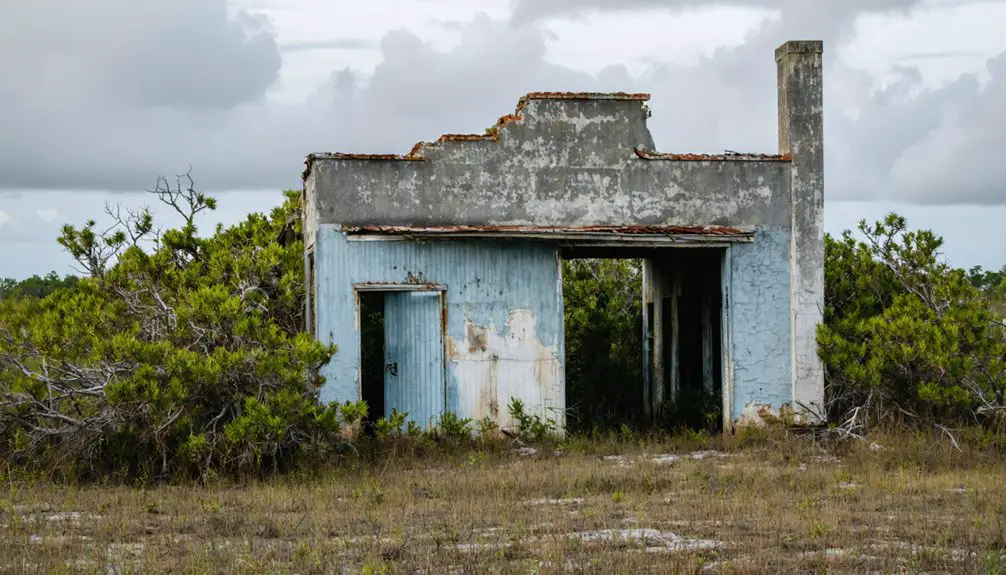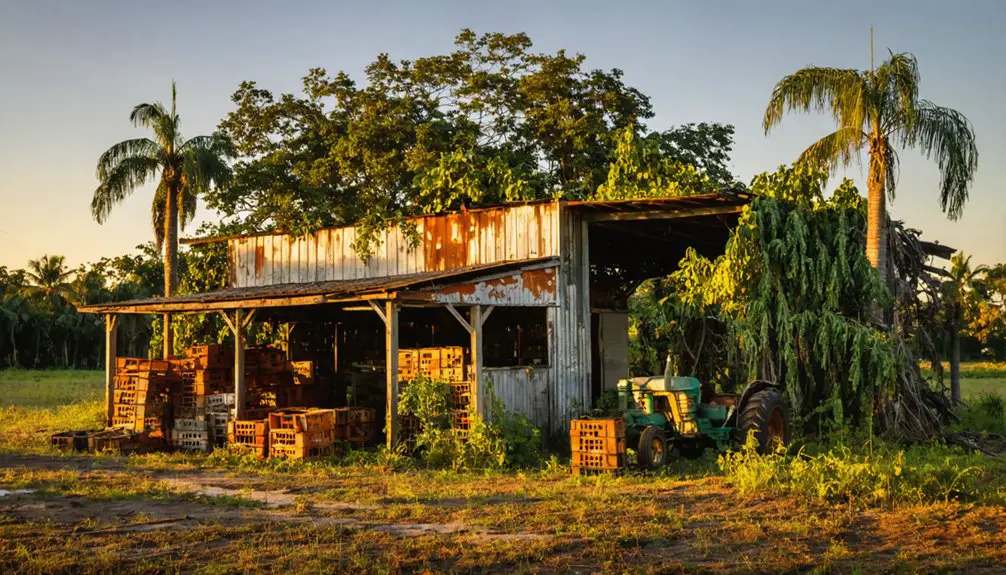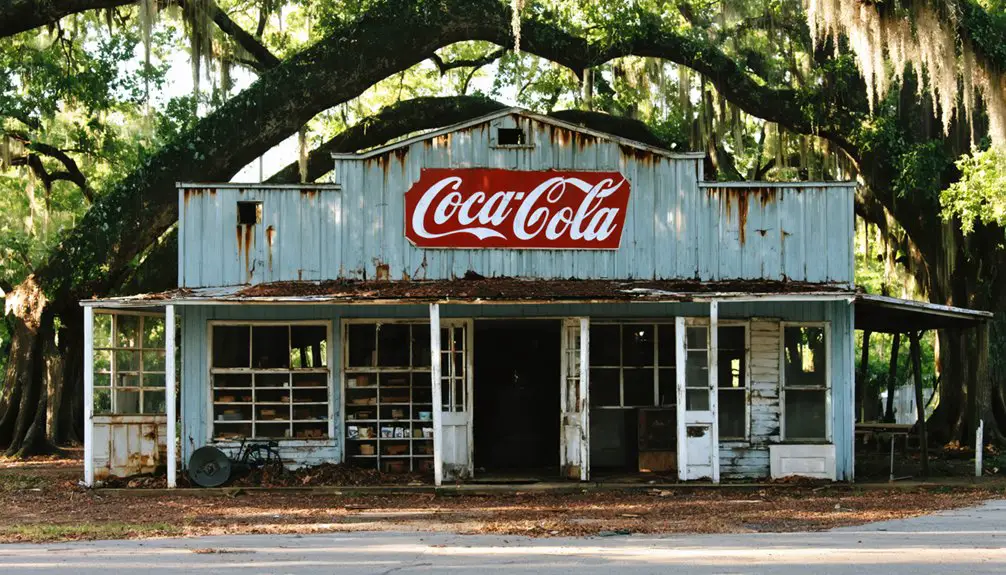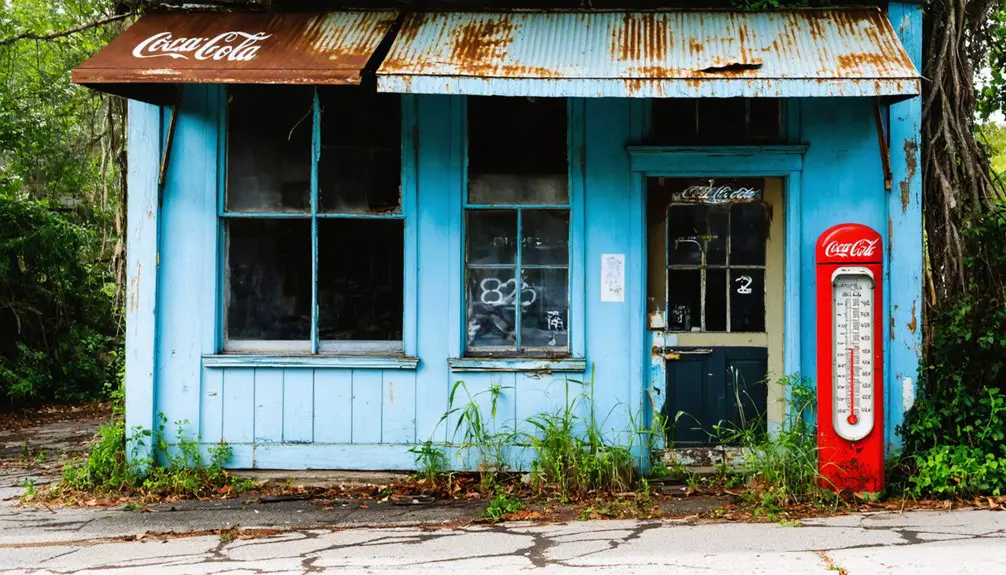You’ll find Geerworth’s remains 9 miles east of Belle Glade, where British settlers established an ambitious 16,000-acre agricultural colony in 1921. Led by H.G. Geer and C.C. Chillingworth, the settlement battled Everglades’ harsh conditions until the devastating 1928 Hurricane struck, claiming 2,300 lives and flooding the area with Lake Okeechobee’s waters. While the town’s physical structures vanished, its tragic story lives on through monuments and burial sites across Palm Beach County.
Key Takeaways
- Geerworth was established in 1921 as a British settlement 9 miles east of Belle Glade in Florida’s Everglades.
- The 16,000-acre development, founded by H.G. Geer and C.C. Chillingworth, aimed to transform swampland into profitable agricultural enterprises.
- The devastating 1928 Okeechobee Hurricane caused catastrophic flooding and claimed approximately 2,300 lives in Geerworth.
- Despite initial agricultural success and community development, recurring floods and natural disasters led to Geerworth’s eventual abandonment.
- The settlement’s remains are documented in historical archives, with burial sites located in Pahokee and West Palm Beach cemeteries.
The British Settlement Dream
In the early 1920s, British immigrants flocked to Florida’s Everglades frontier after purchasing substantial land parcels, including a 16,000-acre tract developed by H.G. Geer and C.C. Chillingworth east of Belle Glade.
You’d find these settler aspirations centered on transforming the swampy terrain into profitable agricultural enterprises, with sugarcane as their primary focus.
The British colonists’ vision went beyond farming – they’d planned a complete transformation of the wilderness into a thriving community.
These British pioneers dreamed bigger than crops – they sought to forge a vibrant society from untamed Florida wilderness.
Despite unfamiliarity with the challenging landscape, their community resilience showed in their thorough plans for roads, homes, and infrastructure.
They’d imagined connecting their settlement to Belle Glade via Route 451, creating a sustainable British enclave where families could build new lives under Florida’s warm sun.
The settlement’s promising start was cut short when heavy flooding in 1922 devastated the newly established colony.
Early Days and Development Plans
When H.G. Geer and C.C. Chillingworth established Geerworth in 1921, they marketed their 16,000-acre tract primarily to British colonists, selling much of the property in England.
You’ll find that their development strategy centered on creating an agricultural settlement 9 miles east of Belle Glade, complete with planned infrastructure and farmland parcels. Like many Florida settlements during the era’s land boom of 1920s, their venture was heavily promoted to potential buyers. The area’s vast cypress forests made it an attractive location for timber harvesting operations.
The founders’ ambitious plans included Route 451, which was meant to connect Geerworth to Belle Glade’s bridge at Torry Island, though this road connection never fully materialized.
British Colony Settlement Plans
British colonial ambitions took shape in 1921 as H.G. Geer and C.C. Chillingworth acquired 16,000 acres near Belle Glade for a new settlement venture.
You’ll find that settler motivations centered on agricultural development, with British immigrants purchasing land directly from England to establish farming communities in Florida. The colonial governance structure followed traditional British models, including local assemblies and church establishments to maintain cultural ties. Similar to earlier colonial settlements, they established a General Assembly system that required governor approval for proposed bills. The settlers planned to cultivate indigo and sugarcane following successful British colonial agricultural practices.
Development plans called for essential infrastructure, including Route 451 to connect Geerworth with the Belle Glade bridge. The settlement aimed to create a distinctly British presence in the region, complete with self-governing institutions.
While ambitious in scope, these plans faced significant environmental challenges, particularly from flooding that would repeatedly test the settlers’ resilience and determination to build their new community.
Land Tract Development Strategy
The ambitious development of Geerworth began in 1921 when H.G. Geer and C.C. Chillingworth acquired a vast 16,000-acre tract east of Belle Glade.
You’ll find their original vision centered on creating a self-sustaining agricultural community, primarily targeting British immigrants seeking farming opportunities in Florida’s rich Everglades soil.
Their land reclamation challenges were significant, as they tackled the complex hydrology of the wetlands while subdividing the tract into family-sized farming plots. The early settlers faced similar hardships to those in Green Pond, where residents relied heavily on citrus grove farming. Like many communities near Lake Okeechobee, they struggled with flooding and drainage issues.
The community farming initiatives emphasized cooperation among settlers, differing from the plantation-style agriculture common in Florida at the time.
While they planned infrastructure, including Route 451 to Belle Glade, most development remained minimal.
The tract’s potential was ultimately undermined by devastating floods, particularly in 1922 and 1928, leading to its eventual abandonment.
Route 451 Connection Proposal
As part of Geerworth’s ambitious infrastructure plans, Route 451 emerged as an essential proposed connection between the fledgling settlement and Belle Glade’s Torry Island bridge in the early 1920s.
You’ll find that this road concept was developed during H.G. Geer and C.C. Chillingworth’s founding of the settlement, aiming to support a growing 16,000-acre development near Nine Mile Bend.
While the historical significance of Route 451 remains as a reflection of early regional planning, you won’t find any physical traces today. Much like Howard Blake’s later decision to make a premature retirement to focus on serious composition, the development faced an abrupt halt.
The road’s development likely never progressed beyond initial planning stages, as devastating natural disasters struck the area. The 1922 floods and the catastrophic 1928 hurricane effectively halted infrastructure expansion, shifting priorities away from new road construction to basic survival needs.
Natural Disasters Strike
Natural disasters dealt devastating blows to Geerworth and neighboring settlements throughout the 20th century, beginning with the catastrophic 1926 Miami Hurricane.
With limited hurricane preparedness, Geerworth’s structures couldn’t withstand the Category 4 winds, while flooding destroyed essential farmland. The community’s resilience was further tested when the 1935 Labor Day Hurricane brought catastrophic storm surge and extreme winds inland. The 1928 Okeechobee Hurricane struck with 160 mph wind gusts, causing widespread destruction across the region. The area would later endure catastrophic damage from Hurricane Andrew in 1992, which left a quarter million Floridians homeless.
You’ll find that subsequent decades brought relentless challenges, as repeated flooding and hurricanes continued to batter the weakened settlement.
The Great Hurricane of 1928

You’ll find the 1928 hurricane’s impact on Florida was catastrophic, with property damage reaching $25 million (about $458 million adjusted) and between 1,810 and 2,300 deaths in Florida alone.
When Lake Okeechobee’s waters breached the inadequate 5 to 8-foot levees, the resulting 10-foot storm surge created devastating floods that left 15,000 families homeless in Palm Beach County.
The emergency response was severely hampered by flooding that persisted for six weeks, with government aid taking up to three days to reach isolated communities where thousands of migrant workers, mainly non-white, lost their lives.
Impact and Death Toll
The Great Hurricane of 1928 claimed between 2,000 and 3,000 lives across the United States, with Florida bearing the brunt of the devastation.
In Geerworth alone, a settlement founded just seven years earlier, the death toll reached an estimated 2,300 souls.
The catastrophe unfolded when Lake Okeechobee‘s waters breached the 5-foot dike, releasing a devastating surge that flooded an area 75 miles wide.
Floodwaters in nearby Belle Glade rose at a terrifying rate of one inch per minute, reaching heights of 7 feet.
The humanitarian consequences were overwhelming – bodies decomposed so rapidly that authorities resorted to burning rather than burial.
You’ll find no trace of Geerworth today; it’s been replaced by endless fields of sugarcane, a silent reminder of nature’s destructive power.
Emergency Response Efforts
When devastating floodwaters inundated Geerworth and surrounding communities, the Miami Red Cross Citizens Relief Committee sprang into action, coordinating a massive emergency response effort.
You’d have seen relief trains arriving with U.S. Senator Joseph Robinson among the first responders, bringing essential supplies like bread, milk, blankets, and medical provisions.
The disaster response faced significant challenges across a 75-mile flood zone, with rescue teams working to save about 200 people stranded on Atwood’s Cay.
Local migrant workers proved vital in the cleanup efforts, while military personnel assisted with emergency operations.
Relief coordination involved federal, state, and local governments working together to repair the Herbert Hoover Dike, restore utilities, and establish emergency shelters.
Medical teams treated over 1,800 injured survivors while fighting to prevent disease outbreaks in temporary camps.
Life in the Lost Colony
Amid the untamed Everglades of 1921, British immigrants established their homesteads in Geerworth, a small colony founded by H.G. Geer and C.C. Chillingworth. Life wasn’t easy on this 16,000-acre tract east of Belle Glade, where community resilience was tested daily through immigrant struggles and environmental challenges.
In Florida’s harsh Everglades, British settlers carved out Geerworth colony, facing nature’s fury and isolation with unwavering determination.
You’d find these pioneering families facing:
- Limited road access, with Route 451 planned but never fully realized
- Isolation from essential services, requiring trips to Belle Glade
- Recurring floods that threatened their farms and homes
- The need to rebuild their settlement after the devastating 1922 flood
Despite these hardships, the British colonists maintained their determination, rebuilding their community by 1924.
They created a tight-knit society centered around farming and shared immigrant experiences until the catastrophic 1928 hurricane ended their dream permanently.
Agricultural Transformation

Following initial settlement in 1921, Geerworth’s agricultural landscape underwent dramatic changes through innovative water management and crop diversification.
You’d have seen farmers tackle challenging soil conditions by implementing crop rotation and sustainable practices, starting with vegetables like tomatoes, peppers, and eggplants.
The Lake Worth Drainage District transformed the region in 1915, converting swampland into productive fields through Orrin Randolph’s strategic canal system.
You could’ve witnessed the evolution as farmers adapted to soil deficiencies by creating custom fertilizer blends rich in copper and manganese.
By the 1960s, Wedgworth Farms led the shift toward sugarcane production, while other operations maintained diverse crops including celery and potatoes.
The Agricultural Reserve’s establishment later protected this farming heritage from encroaching development, preserving both agricultural traditions and essential water resources.
Preserving the Memory
While the agricultural legacy lives on in surrounding fields, the physical remnants of Geerworth survive primarily through dedicated preservation efforts.
Memory preservation efforts focus on the 1928 Hurricane monument in Belle Glade, which commemorates the estimated 2,300 lives lost during that devastating storm.
The historical significance of Geerworth continues through:
Geerworth’s historical footprint endures through documented records, burial grounds, and dedicated preservation work by local historians.
- Formal burial sites in Pahokee and West Palm Beach cemeteries
- Detailed archival records of the town’s 1921 founding by H.G. Geer
- Digital documentation on ghost town databases and historical blogs
- Local historical groups’ ongoing research and oral history collection
You’ll find these preservation initiatives maintain Geerworth’s story through educational outreach, commemorative events, and the monument’s role as a focal point for community remembrance.
Legacy in Florida’s History

Although Geerworth’s physical presence vanished in the catastrophic 1928 hurricane, its legacy endures as a pivotal chapter in Florida’s early 20th-century development.
Through historical reflections, you’ll find that Geerworth’s ambitious agricultural vision and international appeal helped shape Florida’s identity as a destination for global investment and settlement.
The town’s tragic destruction sparked significant changes in Florida’s approach to flood control and emergency management around Lake Okeechobee.
Its cultural influences live on through the region’s strong agricultural heritage, particularly in the sugarcane fields that now blanket its former location.
You can trace Geerworth’s impact in the state’s modern flood protection infrastructure and in the memorials that honor the 2,300 lives lost, reminding you of the resilience that shaped Florida’s development.
Frequently Asked Questions
What Was the Average Cost of Land for British Settlers in Geerworth?
While you can’t find exact land prices, historical records suggest British settler investments in Geerworth would’ve cost around $50-100 per acre, based on comparable sales in Palm Beach County.
How Many Permanent Buildings Were Constructed Before the Town’s Destruction?
You won’t find exact numbers in historical records, but given the area’s flooding and limited building materials, there were likely fewer than 20 basic structures scattered across the town layout.
Did Any Original Geerworth Residents Return to England After the Floods?
You won’t find evidence of original residents returning to England after the devastating floods. Historical records show flood impact likely scattered survivors to nearby Florida towns rather than overseas.
What Crops Were Initially Planned for Cultivation in Geerworth’s Agricultural Development?
You’ll find they planned a diverse crop selection including tomatoes, bell peppers, eggplants, bananas, grapefruit, avocados, oranges, figs, and guava, facing agricultural challenges in Florida’s subtropical climate and rocky soil.
Were There Any Schools or Churches Established During Geerworth’s Brief Existence?
In a million years of searching, you won’t find any school history or church significance in this settlement. Neither schools nor churches were established during its short-lived existence from 1921-1928.
References
- https://www.ghosttowns.com/states/fl/geerworth.html
- https://www.youtube.com/watch?v=ov9YSsKtbDs
- https://palmbeachpast.org/2011/03/palm-beach-countys-lost-towns-the-complete-list/
- https://www.youtube.com/watch?v=2uH02z9JEGc
- https://en.wikipedia.org/wiki/List_of_ghost_towns_in_Florida
- https://en.wikipedia.org/wiki/History_of_West_Palm_Beach
- https://pbchistory.org/wp-content/uploads/2024/05/Florida-History-Tabloid-2024-Print.pdf
- https://en.wikipedia.org/wiki/History_of_Palm_Beach_County
- https://www.journaloffloridastudies.org/0102ghosttowns.html
- https://www.youtube.com/watch?v=Lv9sIPn3NgU



